We’ve chatted about Au Ver a Soie metallic threads before here on Needle ‘n Thread, but I can’t help it! I have to revisit the subject and share them with you again. Why? Because I’ve been working on something sparkly!
When it comes to hand embroidering with metallic threads, it’s true that there’s often a bit of dread involved. That’s usually because we’ve had bad experiences with metallic threads.
Normally, if stitchers across a wide range of disciplines have consistent frustrations with a particular type or brand of thread, I generally figure the problem is not the stitcher – it’s the thread!
Because so many embroiderers have problems with many available metallics on the needlework market today, metallics in general get a bad rap. And that’s unfortunate, because there are metallic threads out there that are better than others, that are easier to stitch with, and that yield lovely results.
Au Ver a Soie’s metallic threads fall into this category. They are by far my favorite metallics to use when I want to add some sparkle to my embroidery projects.
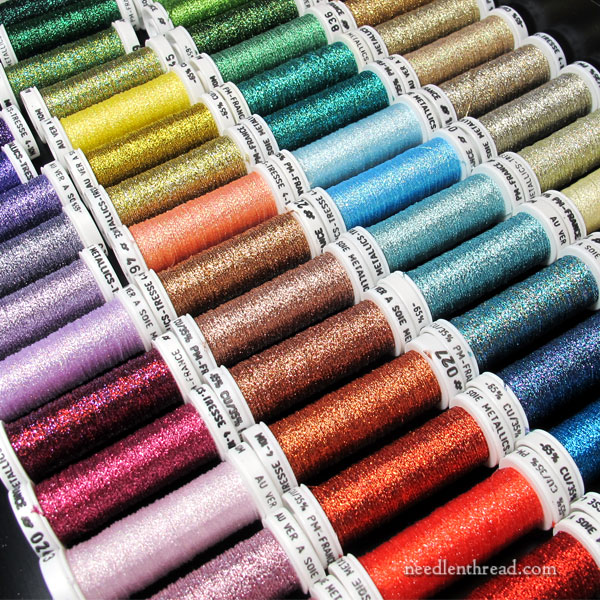
There is something very, very satisfying about seeing a whole collection of threads laid out in a nice drawer, isn’t there? It makes my mouth water.
Last year, I designed a collection of snowflake ornaments for Christmas, and I used several of Au Ver a Soie’s metallics on those ornaments. They were So Much Fun to stitch, and I loved the way they turned out!
Incredibly enough, even though I used metallic threads, the snowflakes were easy and relatively quick to stitch up. And I contend a lot of that has to do with using this particular line of metallic threads.
So when I started playing with a design idea that’s been floating in my head for the past 9 months (the average gestational period of an embroidery project?), I turned to the same metallic threads, and you know what?
I like this year’s project even better!
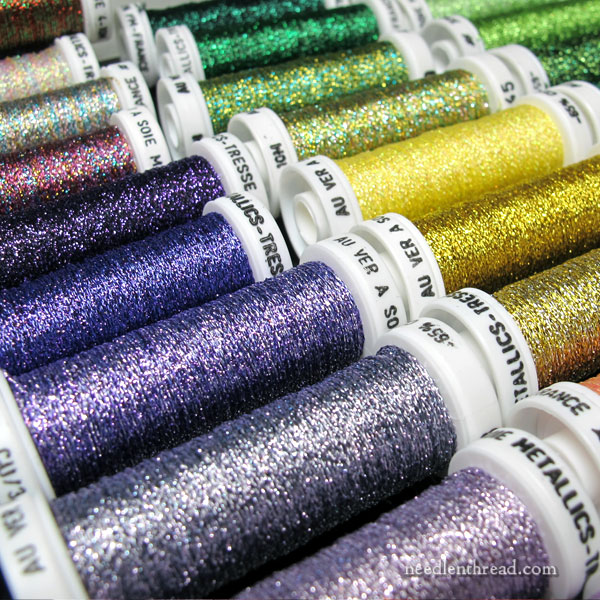
Unfortunately, AVAS metallics are not so widely available in the US.
The French Needle carries some of their metallic thread collections, and Needle in a Haystack carries a limited selection of individual spools.
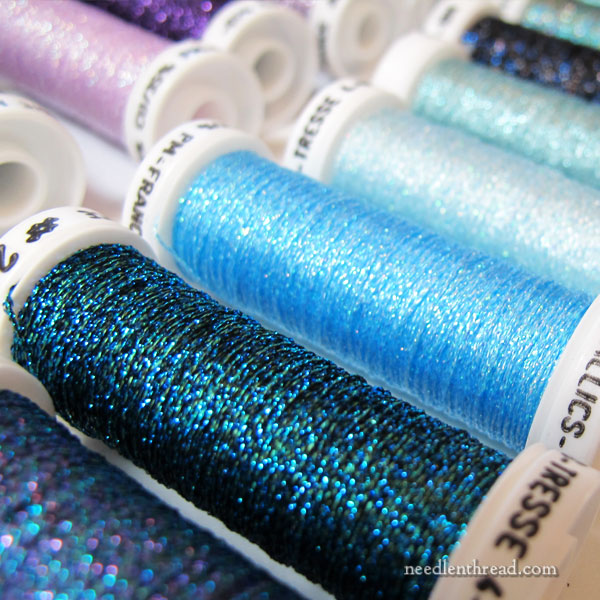
*Sigh!*
(I think the blues are my favorites! I had to incorporate blues in this year’s project, too.)
So, why Au Ver a Soie metallics over other metallic threads on the market, especially when metallics seem to look very similar? After all, they all sparkle!
Well, there’s more to a thread than just the materials it’s made from. There’s a certain engineering that goes into the production of thread, that makes a huge difference in the performance of that thread in various circumstances.
So, while a familiar metallic might work, say, for needlepoint, where the thread passes through large, open holes in a canvas, it might not necessarily hold up as well to passing through a more tightly woven fabric, where friction takes a quicker toll on the thread.
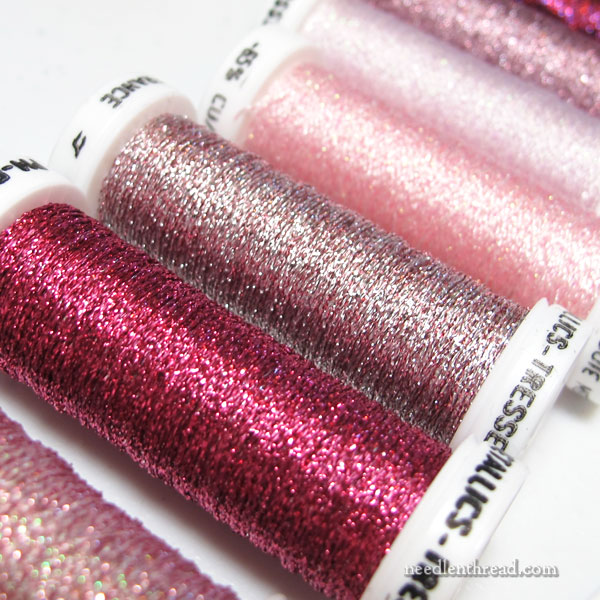
The folks at Au Ver a Soie are thread engineers. They’ve been engineering thread for hundreds of years. They know how to make a thread that is going to work on a variety of fabrics. And I am pretty sure that’s why their metallics hold up better for surface embroidery than most other metallics available today. They’ve put a lot of effort into making sure that their threads – which are highly prized in both the hobby market and the professional couture market – work without driving the stitcher nuts.
And you know what? I’ve never been told by the folks at Au Ver a Soie to run their threads through a thread conditioner to make them work.
If you have to specially treat your thread to embroider with it, don’t you think there’s a problem with the thread? After all, the whole point of needlework thread is for it to be used as needlework thread. You shouldn’t have to add something to it, to make it do its job.
That would be like saying “I’m buying this cup of coffee because I want some caffeine. Now I’m going to buy this Special Coffee Treatment (let’s call it Coffee Heaven!), so that the coffee can do what I originally bought the coffee for.”
When you’re dealing with embroidery thread, it really shouldn’t be that way. The embroidery thread should work for what it is manufactured for, without having to add some kind of treatment to it.
(Note: there’s a difference between strengthening threads with beeswax when doing goldwork or something similar, and having to treat a thread with silicone or something similar in order to get it to pass through fabric unscathed.)
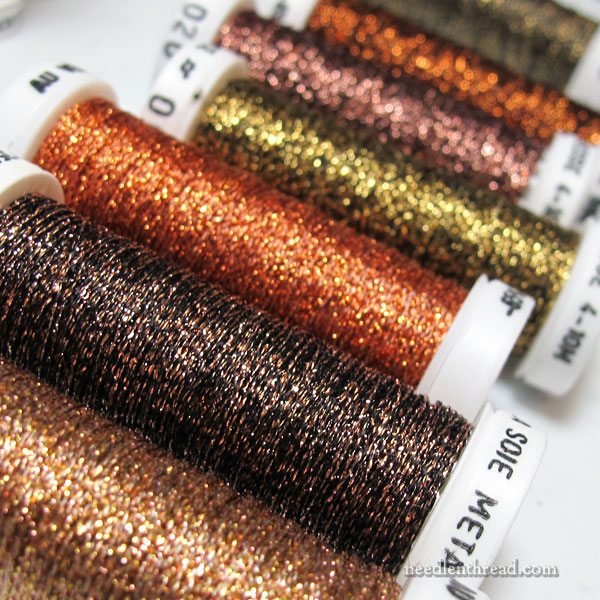
When I began to bring my little holiday project to life this year, it made sense to turn to Au Ver a Soie for metallics again. This year, though, I’ve decided to invest in making a thread, bead, and charm kit for the projects. That way, you can reproduce them, too, without having to seek high and low for materials.
I’m very excited that the kit supplies are starting to arrive!
I’m still working out the logistics on packaging and so forth, but it’s just thrilling to see the whole project coming together. I can’t wait to show it to you!
That’s one of my background adventures here in the studio at the moment. I’ll share more bits with you as the whole project comes together – especially some of the behind-the-scenes work to pull off this type of kitting. I’ve invested in a few new tools to make it happen as efficiently as possible.
This weekend, I’ll be stitching on some sample projects, photographing, getting work-flow areas established, and organizing the month of October. I’m also writing a couple book reviews and working on some embroidery tips to share with you. Busy times!
I hope you have a glorious weekend!